Unit - 1
Engineering Economics, Demand and Supply
Q1) Define economics. What are its features?
A1) Economics is defined because the science that deals with the assembly, distribution and consumption of products and services. Economics, which evolved in the 19th century, has become one of the most important studies of our time. From small shops to countries, economics plays an important role in the efficient operation of both. Businesses cannot thrive without applying the principles of economics. Economics research is extensive and diverse. The nature and scope of economics depends on the interaction of economic agents and therefore the mechanics of the economy. Let's analyze the nature and scope of economics in depth.
Economics is a social science concerned with the production, distribution, and consumption of goods and services. It studies how individuals, businesses, governments, and nations make choices about how to allocate resources. Economics focuses on the actions of human beings, based on assumptions that humans act with rational behaviour, seeking the most optimal level of benefit or utility. The building blocks of economics are the studies of labour and trade. Since there are many possible applications of human labour and many different ways to acquire resources, it is the task of economics to determine which methods yield the best results.
Features of economics are:
The nature of economics deals with the question of whether economics falls into the category of science or art. While various economists are arguing in favor of science, other economists reserve art.
Economics as science
To consider something as science, do we first need to know what science is? Science deals with systematic studies of causality. In science, facts and numbers are collected and systematically analyzed to reach specific conclusions. For these attributes, economics can be considered science. However, economics is treated as a science due to the subsequent characteristics:
It involves a systematic collection of facts and numbers.
Like science, it is based on the formulation of theory and law.
We are dealing with causality.
These points prove that the nature of economics correlates with science. Like science, various economic theories are based on logical reasoning.
Economics as an art
It is said that "knowledge is science and action is art." Economic theory is used to solve various economic problems in society. Therefore, it can be inferred that not only social science but also economics is an art.
Q2) Explain the scope of economics.
A2) Economists use different economic theories to solve different economic problems in society. Its applicability is very vast. From small organizations to multinational corporations, economic law is involved. The scope of economics can be understood in two subheadings: microeconomics and macroeconomics. Let's explain these in detail.
Microeconomics
Microeconomics examines individual economic activities, industries, and their interactions. It has the following features.
Elasticity: Determines the rate of change in the ratio of one variable to another. For example, the income elasticity of demand, the price elasticity of demand, the price elasticity of supply.
Production theory: Includes efficient conversion from input to output. For example, packaging, shipping, storage, manufacturing.
Production cost: With the help of this theory, the price of an object is evaluated by the price of a resource.
Monopoly: Under this theory, the superiority of a single entity is studied in a particular field.
Oligopoly: It corresponds to the domination of small entities in the market.
Macroeconomics
Macroeconomics
It's a study of the economy as a whole. We describe a wide range of aggregates and their interactions "top-down". Macroeconomics has the following characteristics.
Growth: Study the factors that explain economic growth, such as the country's increase in per capita production over the long term.
Business Cycle: This theory emerged after the good Depression of the 1930s. It advocates that central banks and governments develop monetary and fiscal policies and monitor output throughout the business cycle.
Unemployment rate: Measured by the unemployment rate. This is caused by a variety of factors, including rising wages and lack of vacancies.
Inflation and Deflation: Inflation responds to rising commodity prices, and deflation responds to falling commodity prices. These indicators are useful for assessing the economic situation of a country.
Q3) What are the basic problems of an economy?
A3) The basic problems of an economy are”
Problem 1. What to produce and in what quantity?
The first central issue of the economy is deciding which goods and services to produce and in what quantity. This includes the allocation of scarce resources related to the composition of total production in the economy. Due to the lack of resources, society has to decide what products to produce, such as wheat, cloth, roads, televisions, electricity and buildings.
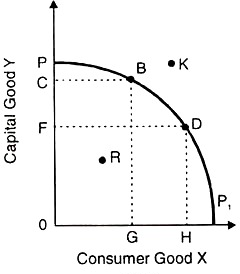
Once the nature of the product to be produced is determined, the quantity is determined. Tonnage of wheat, number of televisions, millions of kilowatts of electricity, number of buildings, etc. Due to the lack of economic resources, the question of the nature and quantity of goods should be determined based on: Social priorities or preferences.
If society prioritizes the production of more consumer goods than it does now, it will be less in the future. A high priority for capital goods means less consumer goods now and in the future. However, due to lack of resources, if one product is mass-produced, another product must be mass-produced.
This problem can also be explained using a productivity curve, as shown in Figure 1.
Suppose the economy produces capital goods and consumer goods. In determining the total output of an economy, society must choose that combination of capital and consumer goods that is in harmony with its resources.
The combination R inside the productivity curve PP1 is not selectable as it reflects the economic inefficiency of the system in the form of resource unemployment. Nor is it possible to select a combination R that is outside the scope of society's current productivity. Society lacks the resources to create this combination of capital and consumer goods.
Therefore, you should choose from combinations Â, E, or D that give you the highest level of satisfaction. If society decides to have more capital goods, it chooses combination B. If you need more consumer goods, choose Combination D.
Problem # 2. How to produce these products?
The next fundamental issue of the economy is determining the technology and methods used to produce the goods needed. This issue depends primarily on the availability of resources within the economy.
If you have a lot of land, it may be extensive farming. If you are short on land, you can use intensive tillage methods. If you have a large workforce, you may use labor-intensive technology. On the other hand, in the case of labor shortage, capital-intensive methods may be used.
The technology used also depends on the type and quantity of products produced. Producing capital goods and large-scale products requires complex and expensive machinery and technology. Simple consumer goods and small products, on the other hand, require small, inexpensive machines and relatively simple technology.
In addition, it is necessary to decide what goods and services will be produced in the public sector and what goods and services will be produced in the private sector. However, when choosing from different production methods, it is necessary to adopt methods that bring about efficient allocation of resources and improve the productivity of the economy as a whole.
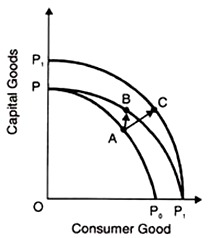
Suppose the economy is producing a certain amount of consumer and capital goods at point A on the PP curve in Figure 2. Considering the supply of elements, adopting new production technology will improve the production efficiency of the economy. As a result, the PP0 curve shifts outward to P1P1.
This will produce more consumer and capital gods from point A on the PP0 curve to point С on the PP, creating a new productivity curve and the economy will produce more of both commodities from point A. Go to.
Problem # 3. For whom is the product produced?
The third basic issue to be decided is the distribution of goods among the members of society. Basic consumer goods and necessities, luxury comfort, and distribution between households are based on the distribution of national income.
Anyone who has the means to buy goods may have it at that time. The rich make up the majority of luxury goods, and the poor may have more of the basic consumer goods they need. This problem is shown in Figure 3. Here, the productivity curve PP shows the combination of luxury goods and necessities.
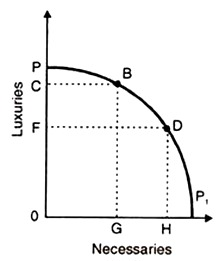
At the point В of the PP curve, the economy has created a lot of luxury for the wealthy and less needed for the art. On the other hand, at point D, we are increasing the OH required for the poor and decreasing the need for the rich.
Problem # 4. How efficiently are your resources being used?
This is one of the key fundamental issues of the economy. Because, after making the previous three decisions, society needs to make sure that its resources are being fully utilized. When economic resources are wasted, we must find ways and means to make full use of them.
If the laziness of resources such as human resources, land and capital is due to male allocation, society needs to adopt such financial, financial or physical measures to remedy this. This is shown in Figure 4. Here, the productivity curve PP reflects the idle resources in the economy at point A, and the productivity curve P1P1 reflects the full utilization of resources at point  or C.

Society produces more capital goods at point Â, more consumer goods at point C, or full employment at point D in an economy where available resources are fully utilized. Decide whether to produce both at the level. It is characterized by technical efficiency or full employment.
To keep it at this level, the economy must constantly increase production of some goods and services by giving up on others.
Problem # 5. Is the economy growing?
The last and most important issue is determining whether the economy is growing or stagnant over time. If the economy is stagnant at any point within the productivity curve, as shown in Figure 5, then you need to move to the productivity curve PP. This causes the economy to produce more consumer and capital goods.
Economic growth occurs through higher capital formation rates, which consist of replacing existing capital goods with new and more productive ones, either by adopting more efficient production technologies or through innovation.
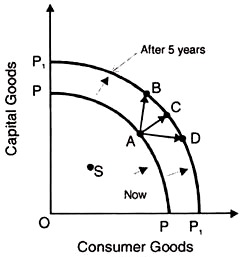
This shifts the productivity curve outward from PP to P1P1. (Fig). The economy moves from point A on the P1P1 curve to В or С or D, for example after 5 years. Point С represents a situation in which both consumer and capital goods are mass-produced in the economy. Economic growth allows the economy to have more of both commodities.
Q4) What do you mean by microeconomics?
A4) Microeconomics (Greek prefix micro-meaning "small") is a branch of economics that studies the behavior of individuals and businesses in making decisions about the allocation of scarce resources. "Interaction between these individuals and businesses"
Microeconomics is a study of individual, household, and corporate behavior in decision making and resource allocation. It generally applies to the market for goods and services and deals with personal and financial issues.
Microeconomics is a study of individual, household, and corporate behavior in decision making and resource allocation. It generally applies to the market for goods and services and deals with personal and financial issues.
Microeconomics is a branch of economics that studies the behavior of individuals and businesses in making decisions about the allocation of scarce resources and their interactions between individuals and businesses.
This is considered to be basic economics. Microeconomics can be defined as a field of economic analysis that studies the economic behavior of individual units, such as individuals, specific households, or specific companies.
The production of goods and services is based on the allocation of scarce resources.
Efficient Goods Distribution – It investigates issues related to
(a) product pricing,
(b) factor pricing, and
(c) economic welfare.
a. Product pricing – Includes product pricing under monopoly, perfect competition, etc., taking into account supply, demand, production costs, and more.
b. Factor Pricing-Prices factor inputs such as land, labor, capital, and organization in the form of rent, wages, interest, and profits, respectively.
c. Economic Welfare – It includes research on the greatest interests for producers and the greatest interests for consumers.
Q5) Explain the concept of macro economics.
A5) The term "macro" was first utilized in economics by Frisch in 1933. However, it came from the 16th and 17th century mercantilists as a methodological approach to economic problems. They were interested in the entire economic system. In the 18th century.
Physiocrats adopted it in the table economy, showing a "cycle of wealth" (i.e., net production) among the three classes represented by the peasant, landowner, and barren classes.
Malthus, Sismondi and Marx within the 19th century addressed macroeconomic issues. Walrus, Wicksell and Fisher contributed modernly to the development of pre-Keynes macroeconomic analysis.
Certain economists such as Cassel, Marshall, Pigoubian, Robertson, Hayek, and Hortley developed the Quantity Theory of Money and General Price Theory in the decade following World War I. However, Keynes eventually developed a general theory of income, output, and employment. I have credibility in the wake of the Great Depression.
Economics is the science of producing, exchanging, and consuming various commodities in the economic system. It is a rare resource that can reduce the abundance of human welfare. The central focus of economics is the choice between resource depletion and its alternative uses. The word "economics" comes from the Greek words "oikos" (house) and nemein (manage), which means to manage a household with limited funds.
Macroeconomics is a crucial concept that considers the entire country and works for the welfare of the economy.
1. Business cycle analysis
Timing of economic fluctuations helps prevent or prepare for financial crises and long-term negative situations.
2. Formulation of economic policy
The fiscal and monetary policy system relies entirely on an extensive analysis of the country's macroeconomic situation.
3. Reduce the effects of inflation and deflation
Macroeconomics is primarily aimed at helping governments and financial institutions prepare for a country's economic stability.
4. Promote material welfare
This economic stream provides a broader perspective on social or national issues. Those who want to contribute to the welfare of society need to study macroeconomics.
5. Regulate the economic system
It continues to guarantee or check the proper functioning and actual position of the country's economy.
6. Solve economic problems
Macroeconomic theory and problem analysis help economists and governments understand the causes and possible solutions to such macro-level problems.
7. Economic development
By utilizing macroeconomic data to respond to various economic conditions, the door to national growth will be opened.
Q6) What is the meaning of demand?
A6) Demand can be defined as an economic principle related to a consumer's desire to purchase a product or service and their willingness to pay for the purchase of a particular product or service.
The definition of demand is the consumer's desire to buy goods and services and the willingness to pay the price required to buy them. Demand is one of the major components of the economy. When we talk about the demand for goods and services, we talk about not only the single quantity requested, but also the complete demand curve.
Demand for products and services is affected by fluctuations in product prices. According to the law of demand, as the price of a product rises, the demand for the product decreases. All other factors remain constant and vice versa.
As a result, companies spend enormous amounts of money determining the demand for products and services in the market. How many items can be sold at a particular price?
Companies need to accurately estimate market demand. A false estimate can leave money on the table if demand is undervalued and can lead to a loss of invested capital if demand is overvalued. Demand is the fuel to keep your business and economy running. If there is no demand in the market, no company wants to produce anything.
There is a close relationship between supply and demand. Consumers try to pay as little as possible for the goods and services they want to buy, while suppliers want to make as much profit as possible. Therefore, the demand for goods and services is directly proportional to the prices of goods and services, and companies need to correctly price goods and services so that they are available to both suppliers and consumers.
If the cost of a product is too high, the demand will decrease as a result of the supplier not selling well, and customers will move to competitors who offer similar products at affordable prices. In contrast, suppliers can attract a large number of customers by keeping the prices of their products and services low. Still, low prices cannot cover the costs of the supplier, so despite the large number of customers, the supplier suffers losses or small profits.
Q7) Explain the two types of demand function.
A7) The two types of demand function are:
- Linear demand function
- Non linear demand function
Linear demand function
In a linear demand function, the slope of the demand curve remains constant throughout its length. The linear demand equation is mathematically expressed as:
Dx = a – bPx
In this equation, a represents the aggregate demand at zero price.
b = Slope or relationship between Dx and Px
b can also be represented by the change in Dx with respect to the change in Px.
If you know the values of a and b, you can calculate the demand for goods at any price using the formula above.
For example, let us assume a = 50, b = 2.5, and Px= 10:
Demand function is:
Dx = 50 – 2.5 (Px)
Therefore, Dx = 50 – 2.5 (10)
or Dx= 25 unit
The demand schedule for the above function is given in Table
QUANTITY DEMANDED OF | PRICE LEVELS OF |
5 | 18 |
10 | 16 |
15 | 14 |
20 | 12 |
When the demand schedule is plotted on a graph, it produces a linear demand curve, which is shown in Figure below.
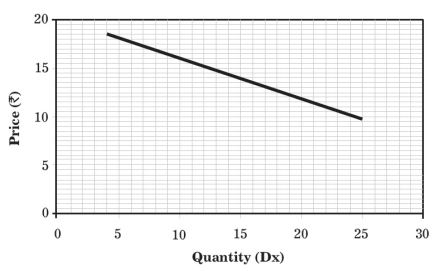
Demand Curve in Linear Demand Function
Non-linear demand function
In a non-linear or curved demand function, the slope of the demand curve (ΔP / ΔQ) changes along the demand curve. Instead of a demand line, a non-linear demand function produces a demand curve.
The nonlinear demand equation is mathematically expressed as:
Dx = a (Px) -2
Or a rectangular hyperbola of the form:
Dx = a / Px + c
Where a, b, c> 0
The price index of the non-linear demand function –b refers to the coefficient of price elasticity of demand.
Figure, represents a non-linear demand function:
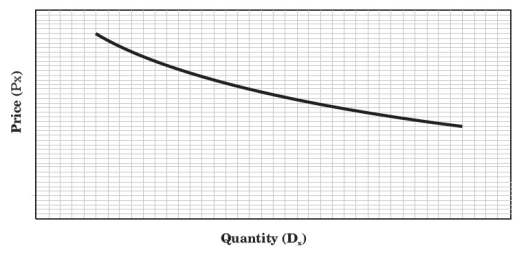
Non linear Demand Function
Q8) Explain Law of Demand.
A8) The law of demand states that other factors being constant (cetris peribus), price and quantity demand of any good and service are inversely related to each other. When the price of a product increases, the demand for the same product will fall.
The law of demand states that all other factors remain constant or equal, an increase in the price causes a decrease in the quantity demanded and a decrease in goods or services price leads to increase in the quantity demanded. Thus, it expresses an inverse relationship between price and demand.
For example, at Rs 70 per kg consumer may demand 2 kg of apple. On the other hand, the price rises to 100/- per kg then he may demand 1 kg of apple
Assumption of law of demand
- No change in the income
- No change in size population
- No change in price of related goods
- No change in consumers taste, preferences, etc
- No expectation of a price change in future
- No change in climate conditions
Given these assumption, the law of demand is explained in the below table –
Price (Rs) | Quantity demanded |
10 | 10 |
8 | 20 |
6 | 30 |
4 | 40 |
2 | 50 |
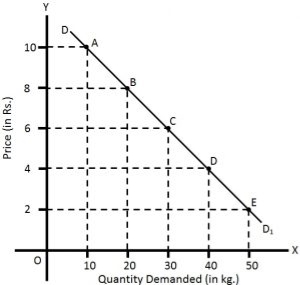
The above table shows that when the price of apple, is Rs. 10 per kg, 10 kg are demanded. If the price falls to Rs.8, the demand increases to 20 kg. Similarly, when the price declines to Rs 2, the demand increases to 50 kg. This indicates the inverse relation between price and demand.
Also, in the above figure the demand curve slopes downwards as the price decreases, the quantity demanded increases.
Q9) What are the exceptions of law of demand?
A9) Keep in mind that in most cases the law of demand applies. Prices will continue to fluctuate until equilibrium is formed. However, there are some exceptions to the law of demand. These include Giffen goods, Veblen goods, possible price changes, and essentials. Let's elaborate on these exceptions.
- Giffen goods
Giffen Goods is a concept introduced by Sir Robert Giffen. These products are inferior to luxury products. However, a unique feature of Giffen goods is that as prices rise, so does demand. And this feature is an exception to the law of demand.
The Irish potato famine is a classic example of the concept of Giffen goods. Potatoes are the staple food of Ireland. During the potato famine, when potato prices rose, people spent less on premium foods such as meat and bought more potatoes to stick to their diet. As the price of potatoes went up, so did the demand. This is a complete reversal of the law of demand.
b. Veblen goods
The second exception to the law of demand is the concept of Veblen goods. The Veblen goods are a concept named after the economist Thorstein Veblen, who introduced the theory of "exaggerated consumption". According to Veblen, there are certain products that increase in value as prices go up. When a product is expensive, its value and usefulness are perceived to be higher, and therefore the demand for that product increases.
And this mainly occurs in precious metals such as gold and diamonds, stones, and luxury cars such as Rolls-Royce. As the price of these items rises, so does the demand as they become status symbols.
c. Expectations for price fluctuations
In addition to Giffen and Veblen goods, another exception to the law of demand is the forecast of price fluctuations. The price of the product will rise and the product may become more expensive depending on the market conditions. In such cases, consumers may purchase more of these products before the price rises further. As a result, if prices go down or are expected to go down further, consumers may postpone their purchases to take advantage of the low prices.
For example, the price of onions has risen considerably these days. Consumers began to buy and store more onions for fear of further price increases, resulting in increased demand.
In addition, consumers may purchase and store products for fear of shortages. Therefore, even if the price of a product rises, the demand associated with it may increase as the product is taken off the shelf or no longer on the market.
d. Necessary products and services
Another exception to the law of demand is the required or basic merchandise. As prices go up, you'll continue to buy essentials such as medicine and basic staples such as sugar and salt. The prices of these products do not affect the associated demand.
e. Changes in income
Changes in income may change the demand for goods. Increasing household income can lead to more products being purchased, regardless of rising prices, which increases demand for products. Similarly, if your income goes down, you may postpone your purchase of the product, even if the price goes down. Therefore, changes in consumer income patterns can also be an exception to the law of demand.
Q10) What are the determinants of demand?
A10) Top 10 Determinants of Demand for an Economy
1-Price of goods or services
When the price of goods and services goes up, the demand for quantity goes down, and when the price of goods and services goes down, the demand for quantity goes up. Also known as the law of demand.
When the demand does not change even with the price change called inelastic demand, and when the quantitative demand changes more than the price change called elastic demand.
2 – Prices for alternative / complementary goods and services
Alternatives are products that meet the same needs. For example, peanut oil and sunflower oil, and tea and coffee are alternatives to each other, so higher prices for peanut oil can increase demand for sunflower oil. The reverse is also true.
Complementary goods are commodities that are consumed together, such as Car & Diesel and Tea & sugar, which increase the price of Car and decrease the demand for both Diesel & Car.
3-Buyer preferences and preferences
Product demand can change based on buyer preferences and preferences, and brand advertising plays an important role in changing buyer preferences and preferences. For example, we used to think that chocolate was primarily for children, but the advertising industry changed this notion by showing that chocolate is for everyone from children to the very elderly.
Similarly, they constantly come up with new trends in the market that affect their customers and ultimately affect the demand for their products.
4 – Buyer expectations for future prices of goods
When people expect the price of something to go up in the future, they tend to buy more of those products, which leads to an increase in demand for those products. For example, when people expect the price of gold to go up, they will buy more and more gold, and vice versa.
“The same thing happened in the 2015 housing bubble, when house prices were rising, but people were willing to buy homes when the process began to decline during the recession.
People weren't buying a home, even though home prices went down.
5 – Changes in buyers' real income or wealth
The purchasing power of a buyer depends on income and wealth. Demand for goods and services is much lower than in developed countries in undeveloped areas where jobs are not readily available and people earn less. Cities like New York, where many jobs are available, have good income and purchasing power, and demand for goods and services is high.
It is very easy to distinguish that luxury goods in cities with more jobs are always in high demand compared to cities with less employment opportunities. Consumption is based not only on income, but also on higher consumption of wealth and vice versa.
6-Buyer Expectations for Future Income and Wealth
Higher expectations for future income and wealth increase consumption, and lower expectations for future income decrease consumption.
For example, students who have completed higher education and are looking to get a job will start spending more than those with salaries who will retire in the next few years.
7 – Number of buyers
Increasing the number of buyers who are willing to buy goods and services will affect overall demand. Population has a big impact on demand. Population growth can be an ad hoc demand curve.
New buyers help increase quantity demand. In this case, the demand will change even if the price does not change.
8 – Government Policy
For many products, demand depends on government policy. For example, lower borrowing rates lead to increased demand for mortgages as people start buying homes as mortgage rates fall.
As another example, the US government has banned some models of Volkswagen due to pollution issues, so there is no demand for those models in the United States. Taxation also affects the demand for products. A tax increase will lead to higher product prices and lower demand for that product.
9 – Climate change
There are many products whose demand is seasonal or whose demand depends on the climate.
For example, the demand for winter clothes is high in the winter season and the demand for ice cream is high in the summer season. If winter is over and there is no demand for winter clothing companies to sell winter clothing at a discounted price, discount sales will be available at shops and malls after the end of the season. This discount offer helps sellers increase demand.
10 – Income distribution
Demand for luxury goods is high in areas where very wealthy people are staying, while demand for luxury goods is low in undeveloped areas where middle-income people are staying.
Q11) What is elasticity of demand? Give example.
A11) The elasticity of demand formula is calculated by dividing the percentage that quantity changes by the percentage price changes in a given period. It looks like this:
Elasticity = % change in quantity / % change in price
Therefore, the elasticity of demand is the percentage change in the quantity demanded as a result of a percentage change in the price of a product. Because the demand for certain products is more responsive to price changes, demand can be elastic or inelastic. When the demand for a product is elastic, the quality demanded is highly responsive to price changes. When the demand for a product is inelastic, the quality demanded responds poorly to price changes. Thus, a change in price will affect an elastic product’s demand, but it will have little effect on an inelastic product’s demand.
The variables that demand may depend on are:
Product price
Prices of related products
Consumer income, etc.
Elasticity of demand
Let's look at some examples.
The price of the radio goes down from the rupee. 400 rupees 400 per unit. As a result, demand will increase from 100 to 150.
Government subsidies will bring wheat prices down from the rupee. From 10 / kg to Rs. 9 / kg. This will increase demand from 500 kilograms to 520 kilograms.
In both of the above cases, we can see that as the price goes down, the demand goes up. Therefore, the demand for radio and wheat responds to price fluctuations
Example
The price of a commodity decreases from Rs.6 to Rs. 4. This results in an increase in the quantity demanded from 10 units to 15 units. Find the coefficient of price elasticity.
Ans: The Coefficient of price elasticity $$= E_p = \frac {\Delta q} {\Delta p} \times \frac{p}{q} $$
Where, q is quantity, p is price and Δ is the change.
Therefore, we have
Δq=15–10=5
Δp=6–4=2
Hence,
=Ep=52×610=1.5
Q12) Suppose income is constant at Rs. 3,000 per year, present price of a good is Rs. 10 and present quantity demanded is 125 units per month. Now the price falls to Rs. 9 and a large quantity of 150 units per month is likely to be demanded. What is the arc price elasticity over this range of the demand curve?
A12) Substituting values into the arc elasticity formula, we get:

What is the significance of the calculated elasticity coefficient? It simply indicates that quantity expands by 1.73% for each 1% fall in price over the relevant range of the demand curve. The negative value of the coefficient of demand elasticity simply implies that quantity Q goes up when P falls and vice-versa.
The virtue of this method of calculation is that it is a more accurate measure than if we had used the initial or final P and Q bases. This is because, when we deal with a range over which the price varies, it is always better to obtain a measure that reflects the average degree of consumer responsiveness.
For discrete (big) or once-for-all P change, we make use of the above formula. However, as a special case of arc elasticity we may use the concept of point elasticity. For small (or continuous) P and Q changes, Ep can be calculated for a point on the demand function, so as to be called point price elasticity.
Q13) Explain inelastic demand. Give example.
A13) Inelastic demand in economics is defined as the absence of a change in the demanded quantity of goods whenever there is a slight change in demand for quantity or a change in consumer behavior, or a change in the price of the product. Yes, and this can be determined as follows: Divide the rate of change in demand by the rate of change in price. This article provides a practical example of the demand for inelasticity.
Example
Gasoline is one of the types of products observed in the market where consumers buy the same amount when the same price goes up, and conversely, when the price of gasoline goes down, consumers don't buy any more. Buy only the same quantity in quantity. We need to discuss this scenario from an economic point of view.
Solution
Consumers act differently on different types of products, depending on their needs, requirements and preferences. Therefore, in economics, it is classified into regular goods, luxury goods, and essential goods. Gasoline is a necessity or defective product that consumers prefer to buy the same amount, regardless of whether the price of gasoline rises or falls. This kind of situation in economics is called the demand for inelastic elasticity, where prices fluctuate but the demand for quantity remains the same.
Q14) What is demand forecasting?
A14) Forecasting is the use of historical sales data to forecast future demand for a product or service. It provides an estimate of the number of goods or services that a customer expects to request within a specific time period in the future.
It identifies what current and future customers want to buy and uses this information to optimize purchase orders or manufacturing.
Demand forecasting also allows companies to make informed decisions about their supply chain.
Estimates of future total sales and revenue are the main results of demand forecasting. These make inventory planning, future warehouse management needs, and sales decisions easier and more accurate.
Important estimates in business operations also depend on demand forecasts. These include inventory turnover, cash flow, profit margin, risk management, and capacity planning, among others.
Forecasting is an area of predictive analytics in the business that deals with supply chain optimization and overall inventory management. Compare past demand records for products with current market trends to make accurate quotes.
Every company wants to be able to predict the amount of cost it will incur to meet its customers' demands. Forecasting is one way to do this.
This is a method for estimating the expected demand for future products or services. It is based on an analysis of past demand for that product or service in current market conditions. Demand forecasts should be evidence-based and take into account the facts and events associated with the forecasts.
So, simply put, after gathering information about different aspects of the market and demand based on the past, attempts may be made to estimate future demand. This concept is called demand forecasting.
For example, suppose you sell 200, 250, and 300 units of Product X in January, February, and March, respectively. With this, it can be said that there is a demand for about 250 units. If market conditions do not change, for product X in April.
Q15) Explain unitary elastic
A15) If the elasticity coefficient is equal to one, demand is unitarily elastic as shown in Figure 3. For example, a 10% quantity change divided by a 10% price change is one. This means that a 1% change in quantity occurs for every 1% change in price.
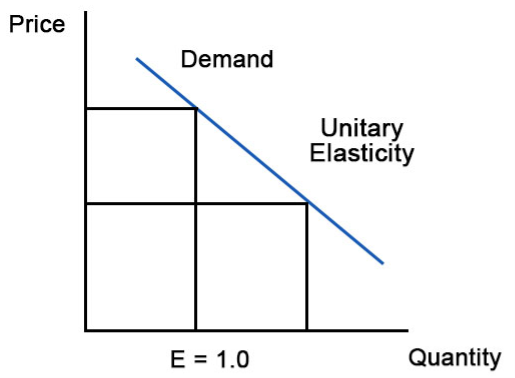
Elasticity can be calculated in two ways. First, it is as the mean over a range of demand functions, in which case it is called the arc elasticity.
Arc price elasticity can be calculated using the following midpoint formula:
Demand arc price elasticity
The formula for calculating the arc elasticity can be expressed as:
Arc elasticity calculation formula
Where Ep is the amount of arc elasticity required for the price.
P1 and Q1 are the original price and quantity,
P2 and Q2 are the final price and quantity,
∆P is an absolute change in price,
∆Q is the absolute change in quantity.
Note that Ep is always a pure number such as 1, 1/2, 1/4, etc., as it is a rate of change of 2 percent.
The demand curve slopes downward, so either ΔP or ΔQ is negative. Therefore, the calculated value of elasticity has a negative sign.
The arc price elasticity can be calculated based on the midpoint formula. If Ep> 1, the demand is said to be elastic. If the demand for Ep = 1 is unielastic and the demand for Ep <1 is inelastic. Consider the following example.